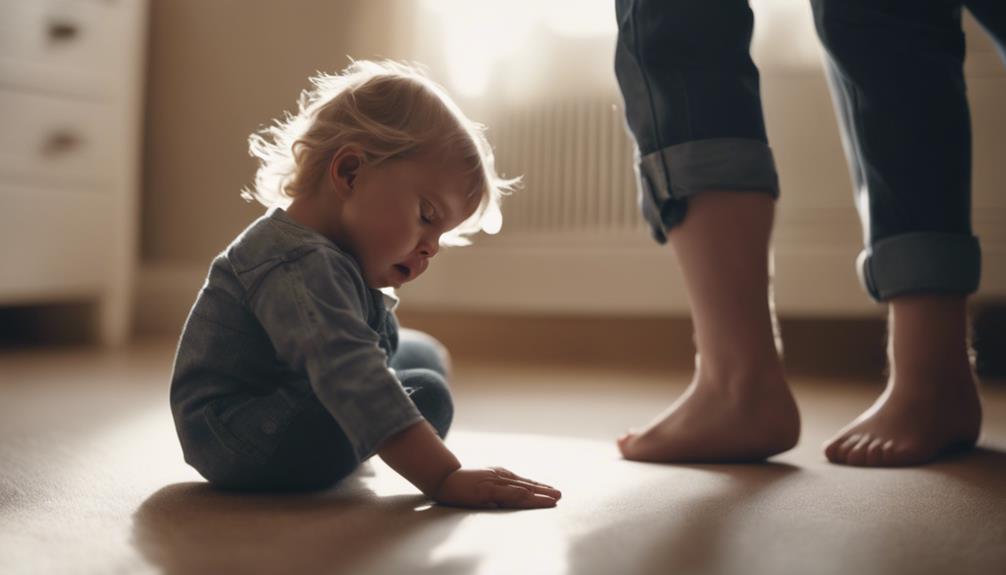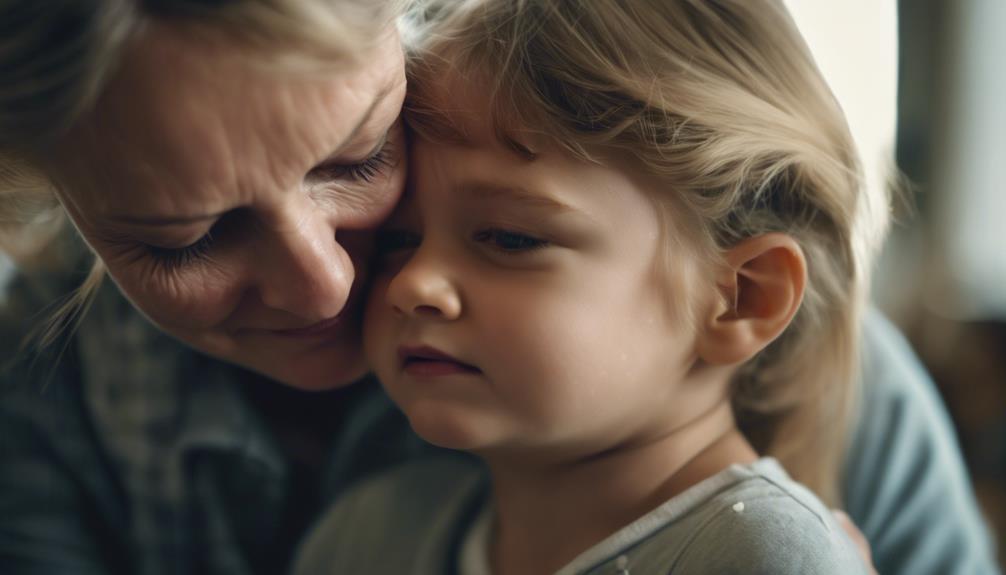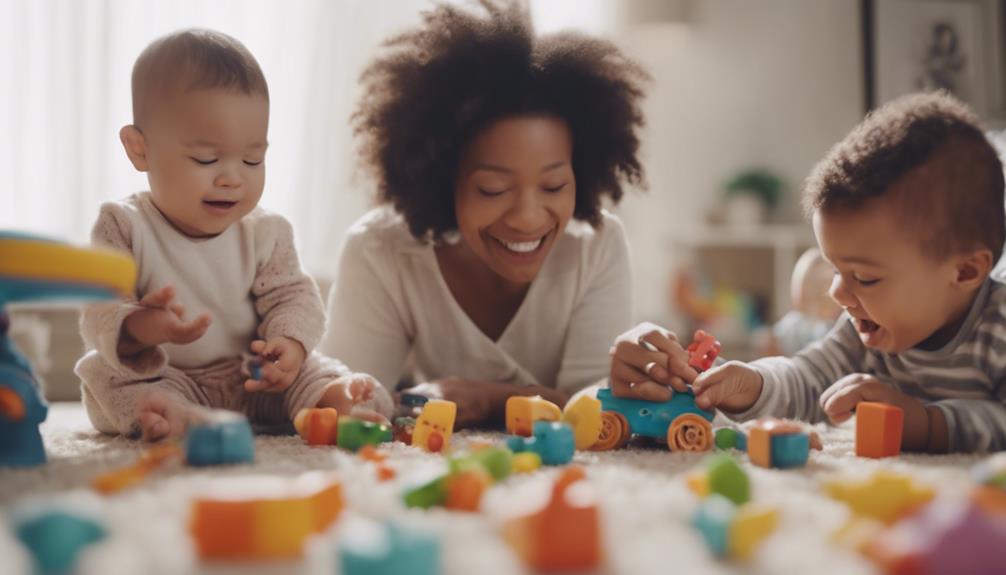Understanding separation anxiety in babies and toddlers is essential. Causes can range from developmental milestones to significant life changes. Signs like clinginess, fear of strangers, and crying during separations are common. Coping strategies include sticking to routines, short separations, and seeking guidance. Separation anxiety can greatly impact family dynamics and attachment bonds. Professional interventions, such as counseling and creating supportive environments, can offer assistance. Effective coping mechanisms include maintaining consistent routines and seeking professional help for lasting solutions. By grasping these elements, you ensure the well-being and healthy growth of your little ones.
Key Takeaways
- Developmental milestones trigger separation anxiety in babies and toddlers.
- Object permanence contributes to feelings of insecurity during separations.
- Secure attachment can help mitigate separation anxiety in children.
- Coping strategies include routines, short separations, and seeking guidance.
- Separation anxiety impacts family dynamics, attachment bonds, and relationships.
Causes of Separation Anxiety
The causes of separation anxiety in children can be attributed to various factors, including developmental milestones and major life changes. During childhood development, milestones like object permanence play a significant role in triggering separation anxiety. As children start to understand that objects and people exist even when they're out of sight, they may struggle with the absence of a caregiver, leading to feelings of insecurity and fear of separation.
Additionally, major life changes such as the arrival of a new sibling can disrupt a child's sense of security and attachment, intensifying separation anxiety.
Secure attachment plays an important role in mitigating separation anxiety. When children have a strong bond with their caregivers, they feel more confident and secure when faced with temporary separations. On the contrary, parenting styles that discourage independence may exacerbate clinginess and separation anxiety in children, hindering their ability to cope with separations effectively.
Signs in Babies and Toddlers
Understanding the signs of separation anxiety in babies and toddlers is essential for caregivers to provide support and reassurance during challenging moments of increased clinginess and fear of separation. Here are key signs to look out for:
- Increased Clinginess: Babies and toddlers may become more attached and clingy to their primary caregiver, seeking constant reassurance and proximity.
- Fear of Strangers: Infants might exhibit fear or discomfort around unfamiliar faces, preferring familiar individuals.
- Crying when Caregiver Leaves: Babies may cry or become upset when separated from their caregiver, fearing abandonment.
- Fear of Caregiver Not Returning: This fear stems from object permanence development, where babies start understanding that objects (or people) continue to exist even when out of sight, causing distress when separated from their caregiver.
These signs often peak around 9 months of age, but can also resurface during toddlerhood. It's essential for caregivers to be patient and understanding during these phases of heightened separation anxiety.
Coping Strategies for Families

To effectively manage separation anxiety within your family, consider implementing practical coping strategies that promote a sense of security and comfort for your child.
Importance in routines and rituals plays a significant role in easing separation anxiety. Establishing a predictable schedule can help your child feel more secure and prepared for separations.
Providing attention and affection during separations is important; reassuring your child that you'll return builds trust and confidence. Keeping promises of your return time reinforces this trust.
It's also beneficial to practice short separations to help your child get used to being apart from you.
Seeking guidance from a pediatrician or counselor can provide effective coping strategies tailored to your family's needs. Consulting a professional can offer valuable insights and support in managing separation anxiety.
Impact on Family Dynamics

Consider how separation anxiety impacts the dynamics within your family, affecting both caregivers and children in various ways.
Caregivers may experience distress when witnessing their child's anxiety, feeling overwhelmed by the situation.
Children, on the other hand, might exhibit clinginess, tantrums, or trouble sleeping due to their separation anxiety.
Family Dynamics: Separation anxiety can disrupt the usual routines and interactions within the family, requiring adjustments to accommodate the child's needs.
Caregivers Support: Providing support and reassurance to caregivers is essential in helping them manage their own distress while guiding the child through their anxiety.
Impact on Children: Children may struggle with separation anxiety, leading to difficulties in social settings or during changes.
Guidance for Managing: Seeking guidance from healthcare professionals can assist in developing strategies to address separation anxiety effectively, benefiting both caregivers and children in the long run.
Professional Interventions for Support

Seeking professional interventions for support is essential in effectively addressing separation anxiety disorder in both caregivers and children. Family counseling and school cooperation play an important role in providing thorough assistance. Through family counseling, all members can gain a better understanding of the disorder and learn how to support each other during challenging times.
School collaboration is also crucial in creating a supportive environment for the child. Individual counseling for the child can help them develop coping strategies and manage their anxiety more effectively.
Moreover, establishing a less stressful environment at home and school can greatly benefit children dealing with separation anxiety. Educating family members about the disorder is key to fostering patience and empathy. By taking these steps and seeking professional guidance, caregivers can better support their children and help them navigate through the challenges of separation anxiety disorder.
If you're in need of assistance, consider contacting (801) 215-9581 for a free consultation to obtain expert advice on managing your child's anxiety.
Understanding Children's Emotions

Children's emotions play a significant role in the development of separation anxiety. Understanding how emotions evolve in children can help you navigate this challenging phase with empathy and patience.
Children's Emotional Development
Understanding children's emotions is vital for their overall emotional development and well-being. Children, from babies to older kids, go through various stages in their emotional development.
Here are some key points to keep in mind:
- Children's emotional development includes learning to identify, express, and regulate their emotions.
- Understanding emotions helps children build social skills and develop empathy.
- Emotional development in children is influenced by genetics, environment, and experiences.
- Children's emotional development progresses through stages, from basic emotions to more complex feelings.
As a caregiver or family member, it's essential to support children as they navigate their emotional development. This support lays the foundation for healthy relationships and helps children develop independence.
Managing Separation Anxiety
Managing separation anxiety involves creating a supportive environment to help children navigate their emotions effectively. Consistency in routines is key to helping children feel secure and confident during changes.
One effective strategy is to establish a good-bye ritual. This ritual can be as simple as a special wave or saying a specific phrase before leaving. According to child development experts, 'Having a routine can provide a sense of predictability for children, which can help reduce separation anxiety.'
In addition to routines, providing reassurance and comfort can also help ease separation anxiety. Acknowledging your child's feelings and offering support is crucial. Remember, separation anxiety is a normal part of infant development, and with the right approach, children can learn to manage it.
Long-Term Effects and Solutions

When examining the long-term effects of separation anxiety, it's important to take into account how it impacts attachment bonds and relationships over time. Effective coping strategies, such as consistent routines and seeking professional help when needed, can play a significant role in mitigating these effects.
Understanding the significance of early intervention and providing the necessary support can help prevent lasting emotional consequences for the child.
Effects on Attachment Bonds
Long-term effects of separation anxiety can impair the formation of secure attachment bonds, impacting trust and relationships in adulthood. Children experiencing unresolved separation anxiety may face challenges in developing secure attachment bonds, leading to difficulties in trusting others and forming healthy relationships later in life.
- Individuals with unresolved separation anxiety may struggle to establish secure attachment bonds, affecting their ability to trust others.
- The impact of separation anxiety on attachment bonds can extend into adulthood, influencing the quality of relationships.
- Early intervention is vital in addressing separation anxiety and preventing long-term effects on attachment bonds.
- Building a secure attachment bond through consistent care and supportive interventions can help alleviate the effects of separation anxiety on attachment bonds.
Understanding the significance of attachment bonds and the repercussions of separation anxiety on trust and relationships underscores the importance of early intervention and targeted strategies to promote healthy development.
Effective Coping Strategies
To effectively address the long-term effects of separation anxiety and find lasting solutions, it is important to focus on implementing effective coping strategies early on. Developing healthy coping mechanisms takes time and effort but can greatly help ease separation anxiety in young children. One effective strategy is to provide a special blanket or toy that the child associates with comfort and security. According to child psychologist Dr. Smith, 'Having a transitional object can act as a source of comfort when the child is separated from their caregiver.' Additionally, creating a consistent farewell routine can help the child feel more secure and understand that separation is a normal part of life. Dr. Johnson emphasizes, 'Consistency and predictability can play a significant role in helping children cope with separation anxiety.' By proactively addressing separation anxiety through these strategies, you can support your child in developing resilience and overcoming robust separation anxiety in the long term.
| Coping Strategies | Benefits |
|---|---|
| Special blanket or toy | Comfort and security |
| Consistent farewell routine | Sense of normalcy and predictability |
| Seeking professional help | Effective long-term solutions |
| Supportive environment | Overcoming separation anxiety with resilience |
| Healthy coping mechanisms | Adapting well to future challenges |
Frequently Asked Questions
At What Age Do Babies Get Separation Anxiety?
Babies typically develop separation anxiety around 9 months of age. Signs may start as early as 4-5 months due to object permanence. By 9 months, most infants experience separation anxiety, indicating a normal developmental milestone and secure attachment.
At What Age Does Separation Anxiety Typically Peak?
Separation anxiety typically peaks in babies between 8-10 months and again in toddlers around 14-18 months. During this time, you might notice increased clinginess and crying as your little one forms strong attachments to you.
How Do You Respond to a Baby With Separation Anxiety?
When your baby's anxious, hold them close, whispering soft reassurances. Slowly introduce short separations and maintain reliable routines. Offer a special toy or blanket for comfort. If worries linger, seek advice from a pediatrician for support and guidance.
How to Help a Baby With Separation Anxiety Sleep?
To help a baby with separation anxiety sleep, establish a consistent bedtime routine, offer a security object, stay calm during changes, avoid sneaking out, comfort them if they wake up, and leave calmly to encourage self-soothing.
Conclusion
In summary, understanding separation anxiety in babies and toddlers is essential for families to effectively cope with this common developmental stage. By recognizing the signs, implementing coping strategies, seeking professional support when necessary, and prioritizing children's emotional well-being, families can navigate this challenging time with patience and empathy.
Remember, like a bird learning to fly, your little one will eventually spread their wings and soar, leaving separation anxiety behind as they grow and thrive.










